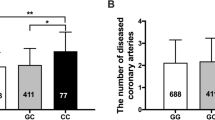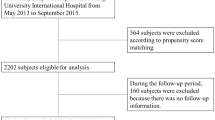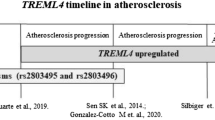Abstract
Genetic factors appear to be important in the process of restenosis after percutaneous coronary intervention (PCI), as well as in inflammation, a pivotal factor in restenosis. An important mediator in the inflammatory response is interleukin (IL)-10. Our aim was to study whether genetic variants in IL-10 predispose to the risk of restenosis. The GENetic DEterminants of Restenosis (GENDER) study included 3104 patients treated with successful PCI. Target vessel revascularization (TVR) was chosen as primary end point. Genotyping of the −2849G/A, −1082G/A, −592C/A and +4259A/G polymorphisms of the IL-10 gene was performed by MassArray platform. After adjusting for clinical variables, three polymorphisms significantly increased the risk of restenosis (−2849AA: relative risk (RR), 1.7, 95% confidence interval (CI), 1.2–2.5; −1082AA: RR, 1.4, 95% CI, 1.1–1.8 and +4259GG: RR, 2.0, 95% CI, 1.4–2.8). To further exclude possible involvement of neighboring genes due to LD in the IL-10 locus, additional polymorphisms were genotyped. The results reveal that association of the IL-10 gene with restenosis is independent of flanking genes. Our findings demonstrate that IL-10 is associated with restenosis and therefore support the hypothesis that anti-inflammatory genes also may be involved in developing restenosis. Furthermore, they may provide a new targeting gene for drug-eluting stents.
This is a preview of subscription content, access via your institution
Access options
Subscribe to this journal
Receive 6 digital issues and online access to articles
$119.00 per year
only $19.83 per issue
Buy this article
- Purchase on Springer Link
- Instant access to full article PDF
Prices may be subject to local taxes which are calculated during checkout


Similar content being viewed by others
References
Mehilli J, Kastrati A, Bollwein H, Dibra A, Schuhlen H, Dirschinger J et al. Gender and restenosis after coronary artery stenting. Eur Heart J 2003; 24: 1523–1530.
Schomig A, Kastrati A, Elezi S, Schuhlen H, Dirschinger J, Dannegger F et al. Bimodal distribution of angiographic measures of restenosis six months after coronary stent placement. Circulation 1997; 96: 3880–3887.
Sharif F, Daly K, Crowley J, O'Brien T . Current status of catheter- and stent-based gene therapy. Cardiovasc Res 2004; 64: 208–216.
Agema WR, Jukema JW, Pimstone SN, Kastelein JJ . Genetic aspects of restenosis after percutaneous coronary interventions: towards more tailored therapy. Eur Heart J 2001; 22: 2058–2074.
Monraats PS, Pires NM, Agema WR, Zwinderman AH, Schepers A, De Maat MP et al. Genetic inflammatory factors predict restenosis after percutaneous coronary interventions. Circulation 2005; 112: 2417–2425.
De Maat MP, Jukema JW, Ye S, Zwinderman AH, Moghaddam PH, Beekman M et al. Effect of the stromelysin-1 promoter on efficacy of pravastatin in coronary atherosclerosis and restenosis. Am J Cardiol 1999; 83: 852–856.
Kastrati A, Koch W, Berger PB, Mehilli J, Stephenson K, Neumann FJ et al. Protective role against restenosis from an interleukin-1 receptor antagonist gene polymorphism in patients treated with coronary stenting. J Am Coll Cardiol 2000; 36: 2168–2173.
Lowe PR, Galley HF, Abdel-Fattah A, Webster NR . Influence of interleukin-10 polymorphisms on interleukin-10 expression and survival in critically ill patients. Crit Care Med 2003; 31: 34–38.
Mazighi M, Pelle A, Gonzalez W, Mtairag EM, Philippe M, Henin D et al. IL-10 inhibits vascular smooth muscle cell activation in vitro and in vivo. Am J Physiol Heart Circ Physiol 2004; 287: H866–H871.
Suarez A, Castro P, Alonso R, Mozo L, Gutierrez C . Interindividual variations in constitutive interleukin-10 messenger RNA and protein levels and their association with genetic polymorphisms. Transplantation 2003; 75: 711–717.
Monraats PS, Pires NM, Schepers A, Agema WR, Boesten LS, de Vries MR et al. Tumor necrosis factor-alpha plays an important role in restenosis development. FASEB J 2005; 19: 1998–2004.
de Jong BA, Westendorp RG, Eskdale J, Uitdehaag BM, Huizinga TW . Frequency of functional interleukin-10 promoter polymorphism is different between relapse-onset and primary progressive multiple sclerosis. Hum Immunol 2002; 63: 281–285.
Koss K, Satsangi J, Fanning GC, Welsh KI, Jewell DP . Cytokine (TNF alpha, LT alpha and IL-10) polymorphisms in inflammatory bowel diseases and normal controls: differential effects on production and allele frequencies. Genes Immun 2000; 1: 185–190.
Kurreeman FA, Schonkeren JJ, Heijmans BT, Toes RE, Huizinga TW . Transcription of the IL10 gene reveals allele-specific regulation at the mRNA level. Hum Mol Genet 2004; 13: 1755–1762.
Westendorp RG, Langermans JA, Huizinga TW, Verweij CL, Sturk A . Genetic influence on cytokine production in meningococcal disease. Lancet 1997; 349: 1912–1913.
Cassatella MA, Meda L, Bonora S, Ceska M, Constantin G . Interleukin 10 (IL-10) inhibits the release of proinflammatory cytokines from human polymorphonuclear leukocytes. Evidence for an autocrine role of tumor necrosis factor and IL-1 beta in mediating the production of IL-8 triggered by lipopolysaccharide. J Exp Med 1993; 178: 2207–2211.
Kasama T, Strieter RM, Lukacs NW, Burdick MD, Kunkel SL . Regulation of neutrophil-derived chemokine expression by IL-10. J Immunol 1994; 152: 3559–3569.
Krakauer T . IL-10 inhibits the adhesion of leukocytic cells to IL-1-activated human endothelial cells. Immunol Lett 1995; 45: 61–65.
Cassatella MA, Meda L, Gasperini S, Calzetti F, Bonora S . Interleukin 10 (IL-10) upregulates IL-1 receptor antagonist production from lipopolysaccharide-stimulated human polymorphonuclear leukocytes by delaying mRNA degradation. J Exp Med 1994; 179: 1695–1699.
Booy R, Nadel S, Hibberd M, Levin M, Newport MJ . Genetic influence on cytokine production in meningococcal disease. Lancet 1997; 349: 1176.
Westendorp RG, van Dunne FM, Kirkwood TB, Helmerhorst FM, Huizinga TW . Optimizing human fertility and survival. Nat Med 2001; 7: 873.
Liu YW, Chen CC, Tseng HP, Chang WC . Lipopolysaccharide-induced transcriptional activation of interleukin-10 is mediated by MAPK- and NF-kappaB-induced CCAAT/enhancer-binding protein delta in mouse macrophages. Cell Signal 2006; 18: 1492–1500.
Riemann M, Endres R, Liptay S, Pfeffer K, Schmid RM . The IkappaB protein Bcl-3 negatively regulates transcription of the IL-10 gene in macrophages. J Immunol 2005; 175: 3560–3568.
Eefting D, Schepers A, de Vries MR, Pires NMM, Grimbergen JM, Lagerweij T et al. The effect of interleukin-10 knock-out and overexpression on neointima formation in hypercholesterolemic ApoE3Leiden mice. Manuscript in progress.
Feldman LJ, Aguirre L, Ziol M, Bridou JP, Nevo N, Michel JB et al. Interleukin-10 inhibits intimal hyperplasia after angioplasty or stent implantation in hypercholesterolemic rabbits. Circulation 2000; 101: 908–916.
Agema WRP, Monraats PS, Zwinderman AH, de Winter RJ, Tio RA, Doevendans PAFM et al. Current PTCA practice and clinical outcomes in The Netherlands: the real world in the pre-drug-eluting stent era. Eur Heart J 2004; 25: 1163–1170.
Li W, Nyholt DR . Marker selection by Akaike information criterion and Bayesian information criterion. Genet Epidemiol 2001; 21 (Suppl 1): S272–S277.
Tanck MW, Klerkx AH, Jukema JW, De Knijff P, Kastelein JJ, Zwinderman AH . Estimation of multilocus haplotype effects using weighted penalised log-likelihood: analysis of five sequence variations at the cholesteryl ester transfer protein gene locus. Ann Hum Genet 2003; 67: 175–184.
Acknowledgements
PS Monraats is supported by Grant 99.210 from the Netherlands Heart Foundation and a grant from the Interuniversity Cardiology Institute of the Netherlands (ICIN). Dr JW Jukema is an Established Clinical Investigator of the Netherlands Heart Foundation (2001 D 032). The study was supported by the Center for Medical Systems Biology (CMSB), a center of excellence approved by the Netherlands Genomics Initiative/Netherlands Organisation for Scientific Research (NWO). The contribution of the members of the clinical event committee, JJ Schipperheyn MD PhD, JW Viersma MD PhD, D Düren MD PhD and J Vainer MD, is gratefully acknowledged. We thank D Kremer and E Suchiman from the Department of Molecular Epidemiology of the Leiden University Medical Center, for their technical assistance. Furthermore, we thank MH Bax from the Department of Cardiology, A van Wengen from the Department of Infectious Diseases and M van Schie and M Kersbergen from the Department of Clinical Chemistry, all from the Leiden University Medical Center, for their technical assistance.
Author information
Authors and Affiliations
Corresponding author
Rights and permissions
About this article
Cite this article
Monraats, P., Kurreeman, F., Pons, D. et al. Interleukin 10: a new risk marker for the development of restenosis after percutaneous coronary intervention. Genes Immun 8, 44–50 (2007). https://doi.org/10.1038/sj.gene.6364343
Received:
Revised:
Accepted:
Published:
Issue Date:
DOI: https://doi.org/10.1038/sj.gene.6364343
Keywords
This article is cited by
-
Treg cells in atherosclerosis
Molecular Biology Reports (2021)
-
T cell co-stimulation and co-inhibition in cardiovascular disease: a double-edged sword
Nature Reviews Cardiology (2019)
-
Genetic risk factors for restenosis after percutaneous coronary intervention in Kazakh population
Human Genomics (2016)
-
Restenosis after PCI. Part 1: pathophysiology and risk factors
Nature Reviews Cardiology (2012)
-
The 5352 A allele of the pro-inflammatory caspase-1 gene predicts late-acquired stent malapposition in STEMI patients treated with sirolimus stents
Heart and Vessels (2011)



